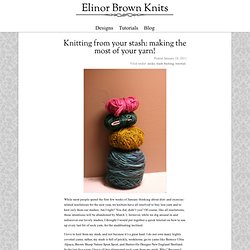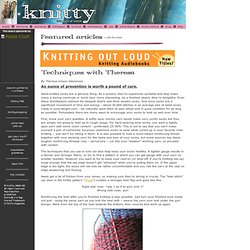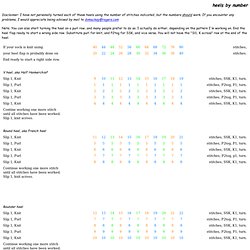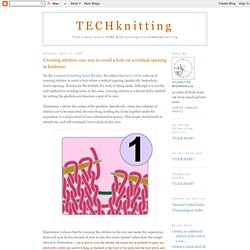

Knit from stash: socks with leftovers, deliberately. While most people spend the first few weeks of January thinking about diet- and exercise-related resolutions for the new year, we knitters have all resolved to buy less yarn and to knit only from our stashes.

Am I right? You did, didn’t you? Of course, like all resolutions, these intentions will be abandoned by March 1; however, while we dig around in and rediscover our lovely stashes, I thought I would put together a quick tutorial on how to use up every last bit of sock yarn, for the stashbusting inclined. I love to knit from my stash, and not because it’s a great haul. I do not own many highly coveted yarns; rather, my stash is full of prickly, workhorse, go-to yarns like Berroco Ultra Alpaca, Brown Sheep Nature Spun Sport, and Harrisville Designs New England Shetland.
Getting Started. Reinforcing socks - Summer 2008. An ounce of prevention is worth a pound of cure.

Hand-knitted socks are a glorious thing. As a project, they’re supremely portable and help make many a boring commute or lunch hour more interesting. As a finished object, they’re delightful. Even Albus Dumbledore claimed his deepest desire was thick woolen socks. And since socks are a significant investment of time and energy - about 34,000 stitches in an average pair of adult socks made in sock-weight yarn - we naturally want them to stay whole and in good condition for as long as possible. First, know your yarn qualities. The techniques that you use to knit can also help keep your socks healthy. Heels get a lot of friction from your shoes, so making sure they’re strong is crucial.
Right side rows: *slip 1 as if to purl, knit 1* Wrong side rows: purl Reinforcing the heel after you’re finished knitting is also possible. I’m using a different color yarn here so you can see it better. Here are some tools you might find helpful: Heels by Number. Heels by number Disclaimer: I have not personally turned each of these heels using the number of stitches indicated, but the numbers should work.

If you encounter any problems, I would appreciate being advised by mail to dvmackay@rogers.com Note: You can also start turning the heel on a purl row, and many people prefer to do so. I actually do either, depending on the pattern I'm working on. End the heel flap ready to start a wrong side row. The math involved in these heels is not hard once you understand how the heel is shaped: Crossing stitches: one way to avoid a hole on a vertical opening in knitwear. On the community knitting board Ravelry, the subject has twicelately come up of crossing stitches to avoid a hole where a vertical opening (pocket slit, buttonhole, sleeve opening, division for the heeltab of a sock) is being made.

Although it is not the only method for avoiding holes in this area, crossing stitches is a decent utility method for solving the problem and deserves a post of its own. Illustration 1 shows the nature of the problem. Specifically, when two columns of stitches are to be separated, the only thing holding the fabric together under the separation is a single stand of yarn (illustrated in green). That single strand tends to stretch out, and will eventually leave a hole in this area. Illustration 2 shows that by crossing the stitches in the row just under the separation, there will now be five strands of yarn to take the strain (green) rather than the single strand in illustration 1.
Illustration 3 shows an application of this principle at the heel tab of a sock. Foot Sizing Survey Results; Contest! Last year, I ran an email survey: I asked knitters to measure the feet of their friends and family, asking for the following data: I got nearly 400 replies, providing meaningful data for foot lengths 8.5-11 inches, foot circumferences 8 to 11 inches.

Disclaimer: although I received replies from all over the world, most of the data I received was from North American knitters. I received more data for women’s feet than men’s. There is inherent risk in getting respondents to take their own measurements: I have to trust that they measured in the right place. I don’t claim that this represents every foot in the world, and I don’t believe it should be taken as the final answer on foot size. Note: when I mention foot circumference, I mean around the ball of the foot. I found some interesting results – some confirming what we felt we knew, as sock knitters, others rather surprising.
-In the vast majority of cases, ankle circumference is the same as the foot circumference. If you have foot length: